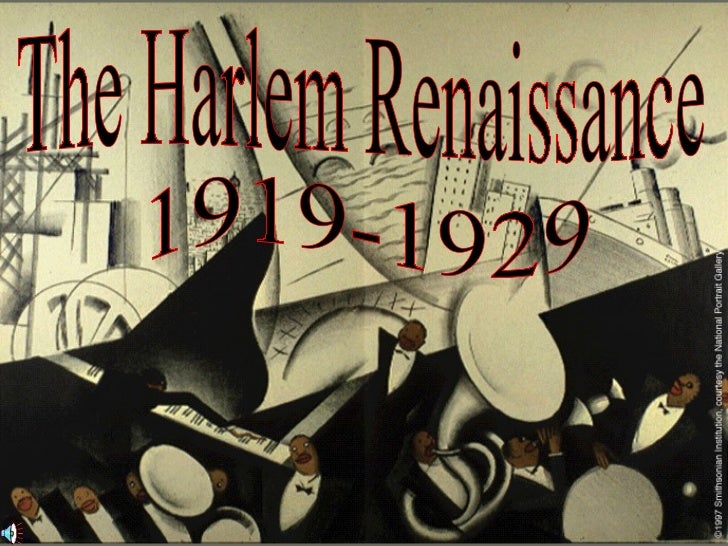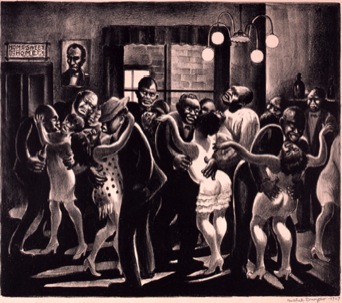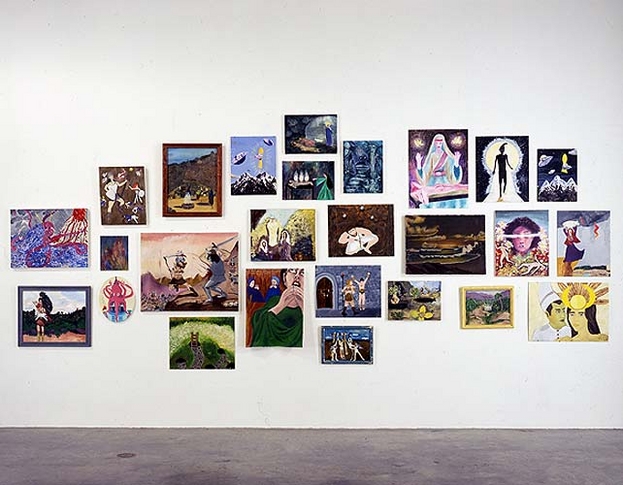This website uses cookies so that we can provide you with the best user experience possible. Cookie information is stored in your browser and performs functions such as recognising you when you return to our website and helping our team to understand which sections of the website you find most interesting and useful.
Author: Zhaolin (Jason) Tong

The Harlem Renaissance occurred in the 1900s in Harlem, a section of New York City. The Harlem Renaissance was a representation of Black culture and identity. The Harlem Renaissance united Blacks and also rescued them from the oppression of living in a White society. During this period, Blacks created many works of art, music, and dance. These artworks expressed the racial identity that had been so oppressed and forgotten, making the Harlem Renaissance extremely significant in Black history. You might even call the Harlem Renaissance, a statement of freedom on behalf of all African Americans. Prior to the 1920s, Blacks were so afraid of making a statement about equality that they lost part of their racial identity. However, after the Chicago Race Riots of 1919, this view began to change. Blacks stopped depending on government for social change. They fought for equality on their own terms. The Harlem Renaissance was precisely a symbol of this change in attitude.
The video had a song about freedom in connection with the Harlem Renaissance. One thing I loved about the video is how uniform the dancers were . It was as if the dancers were “copied and pasted” on the stage: their movements were extremely in sync with one another. Interestingly, towards the end of the clip, the backdrop changed into the segregated setting of the States at post Plessy v. Ferguson case. And at the very end, it showed a uniform identity, or at least an identity that was shared among Blacks and Whites. The idea was manifested in the arm linking between the black dancer to the white dancer. Although this may be a bit too idealistic, even now, it still shows a desire to accomplish social equality in a corrupt world.
When asked about the difficulty of translating his message to dance in an interview, Kyle Abraham mentioned that it was indeed hard. However, he believes that the viewers will be able to note the little things in the performance, such as his putting a black male with a black female or a black male and a white male. There are political backgrounds and information on which the viewers will infer from. With that said, I feel as if one must have some background knowledge of the dance’s context before they can interpret the dance and understand the underlying meaning. Without knowledge of the context, the viewer(s) will be lost.


After reading Turnadot, I noticed one particular thing: the play was quite odd. The story started in the middle of an execution. Following that event, the proposal of the UNKNOWN PRINCE–later discovered to be Calaf, who fell in love with the merciless princess at first sight. Although his father and slave Liu asked him to not take the challenge to marry the princess, Calaf ignores them. Miraculously, he was able to solve all of the riddles posed by the Emperor and the minister. The princess disagrees to marrying Calaf, but in the end, she falls in love with him. As you can probably tell from that short summary, the story was pretty brief and transitioned pretty quickly.
Therefore, I asked myself, what is the theme of this opera? After much pondering, I realized the themes of the opera were women’s merciless character , and cruelty of Chinese dynasty. It’s no coincidence that the writer wanted to begin the play with the exalted, dignified, and scary princess executing a prince. She was unforgiving and didn’t even flinch when she passed the order to execute the prince. How merciless! Later on in the play, we do find out why she was so merciless but does, in the end, yield to the unknown prince.
To portray the totalitarian system of ruling in the dynasty eras of China, the writer puts in the scene of executions and fear. After Calaf finished answering the question, Turnadot seems less than hesitant to end all life in the kingdom if no one can tell her Calaf’s name. This seems to be quite extreme; however, it is somewhat accurate. I say that not based on experience but based on numerous TV shows, produced in China. They demonstrate the ruthlessness of the emperors. If you were so much as to make an unnecessary remark, you would be arrested, tortured, and probably have your head cut off. That’s how ridiculous it was.
My reaction to the videos: After listening to Pavarotti – Nessun Dorma, I can hear the music building off each other, just like the piano and the violin we listened to in class. The sounds built off each other harmoniously, creating quite a pleasant rhythm. However, the Turnadot performance was quite abstruse. I couldn’t quite understand what was going on: I couldn’t understand what she was singing. In short, I’m not a big fan of the opera.

Meme. A meme, as defined by Urban Diction, is an idea, belief or belief system, or pattern of behavior that spreads throughout a culture either vertically by cultural inheritance (as by parents to children) or horizontally by cultural acquisition (as by peers, information media, and entertainment media). In the past decade, memes have increased in popularity and became a modern art form. You either like it or you’re not familiar with it.

Recently, Drake’s music video, Hotline Bling, became extremely popular, but not because of the “awesome music” he creates. Instead, it is the memes that are created after the video is made. The original video is not exceptional and I did not care about it either. How did I find out about his Hotline Bling then? Through the hilarious and ridiculous memes created by others on social media! In fact, the memes of the videos are so widespread, the New York Times even has an article on it.
So what made this video is meme-able? Simple. The video is simple: just him dancing for extended periods of time in front of a plain background that’s constantly changing colors. Because the backdrop is so simple, the social media let their minds run wild with his gestures. The New York Times article calls his moves “concise, universal, more about implication than full expression. The author believes that is what makes his video so meme-able.
“In part, that has to do with the unclutteredness of the video, which mostly surrounds Drake with blank space. There’s also the nature of the dancing itself, which is also more or less blank: a series of slight shifts of weight, quick hand gestures, head bobbles and side-to-side steps. They’re small moves that he repeats — in essence, he’s making a GIF of himself, anticipating what will inevitably happen to him online.”
Here, you can see some of the memes created. Be warned, you may disturb others with your laughter as you watch this.
His dance partner-choreographer, Tanisha Scott, told Complex that Drake knew this was going to cause these interestingly new gifs. For that, he should be respected: he inspired people indirectly to create their own stories based off his dance movement. Dance is about expression of the dancer and the interpretation of the viewer. What better way to express this idea than with such an open video.
In essence, “you don’t meme Drake; Drake memes Drake.”(Caramanica)

 According to a New York Times article, Jim Shaw has “one of the oddest careers in post-Pop, post-Conceptual, latter-day Surrealist art.” His style can be described as “hallucinatory imagination.” Through his style, Shaw can create a fascinating view of the human soul, mind, and spirit of the nation, as shown on the left image. The art shown is from his famous “Thrift Store Paintings.” More of them can be found here.
According to a New York Times article, Jim Shaw has “one of the oddest careers in post-Pop, post-Conceptual, latter-day Surrealist art.” His style can be described as “hallucinatory imagination.” Through his style, Shaw can create a fascinating view of the human soul, mind, and spirit of the nation, as shown on the left image. The art shown is from his famous “Thrift Store Paintings.” More of them can be found here.
What comes to mind when I look at such images? First, they are very abstract in a sense. The art is defined in that in shows no blurred lines and every line is bold and clear cut, but the meaning behind the art must be accounted for by the viewer.
Let’s examine this one, for instance. The setting is calm, the characters in the art is extremely jubilant. I should mention that these characters in the painting seems to be from the lost city of Atlantis… 
One thing that stuck out to me is how none of them are wearing clothes. Is it because Jim Shaw views clothing as a burden to this “free world” the characters are in? The colors in the picture are especially warm and doesn’t harm the eye. There isn’t any especially bold colors like red or yellow. The mood of the sunset is shown from the fading brown into a light Sunkist orange. The skin tone of the characters are peachy in color, and looks very soothing to the eye.
In another article, Shaw is portrayed similarly. According to Jim Shaw, From Trash Bins and Swaps, he is characterized as one who goes through “trash” and uses it to forge “prodigious body of work that melds his eccentric collections with his comic-Surrealist paintings.” He rejects the modern views that art is a keeper of the final truth. He instead believes art as a “human search for spiritual peace.” The New Museum’s associate director and director of exhibitions, Mr. Gioni believes that Shaw’s inspiration lies in the forms of visual culture at the time of disappearance. Indeed, the article asserts that he is what can be known as the underground artist’s underground artist in that “his career has prowled the vicinities of fringe churches, cults, dangerous political movements, visionary art scenes and failed philosophies. Notably, Jim Shaw is one of those artist who doesn’t believe in making art for the market. He has the true artistic freedom that some artists lacks.

Reading the play, I immediately noticed one thing: the script does not do the play justice. It lacks many details and background information. The play also lacked structure. So when I do see this play, I expect some sort of director’s twist on it to clarify any misunderstandings I have about the play. Currently, I see the play as very broad and needs to be narrowed down by the reader/viewer as if looking through a telescope. My interpretation was fogged due to the translation of the play. In translating the play from German to English, I feel as though the play lost part of its identity, causing some of the sentences to be confusing.

The underlying theme of the play is the transition between childhood into adulthood. As the readers may have noticed, most of the characters are in their teens: Moritz, Wendla, Melchoir, etc. The “story,” if that’s what you want to call it, is essentially describing the difficulties the teens faced while going from childhood to adulthood. Actually, I take that back. Let’s make the idea simpler. “Spring Awakening explores the difficulties the teens faced while growing up.” Forget about all that childhood and adulthood nonsense. It’s not really adulthood just yet. Furthermore, the title “Spring Awakening” suggests growth and development. “Spring” as in the beginning of the season, when all the plants and flowers develop again. “Awakening” as in learning and growing: the kids begin to become more exposed to the world. However, the playwright does hit us in the face with a transformer by the end of the play: two of the three previously mentioned children don’t even make it to the end. One dies by suicide. The other dies by abortion. Plot twist eh? Ironic to see such a positive book with such a positive title turn out to be a catastrophe?

Based off of this plot twist, the author is trying to tell us that there is no such thing as a smooth transition from childhood to adulthood. The teen must and will struggle, and the parent must be there to support him/her. Understandably, parenting isn’t easy as seen in Spring Awakening. The teens have a huge journey ahead of them and only those who are ready will survive. Those who can’t handle the pressure, like Moritz, will break and eventually commit suicide… Well maybe not that extreme.

“…the photographer or artist imposes their reality on the picture…” Debra Brehmer, in her article “Every Portrait Tells a Lie,” compared taking a photo to painting a portrait. To serve as an example, she brings up an anecdote of how her father took a picture of her and her brother in front of the large Christmas tree.In his attempt to create an idealized image, which displays the reality that he wants, her father is essentially creating a lie. Her father, in attempt to create an idealized image, which displays the reality that he wants, is essentially creating a lie. Debra Brehmer doesn’t blame her father for it, but she seems to admire the humanistic wants and needs in which she states “Portraiture wants what cannot be had: Life to stop without being dead.” ![]()
The concept is not rare. Many people “pose” in pictures because they want to remember the good times, not the bad. They take pictures for memories, or more specifically, “good” memories.Of course, I can’t speak for those who find the need to take a selfie every hour as if their looks were changing by the hour and they must hold on to the precious moment of each change.
This concept is not only an artistic concept, but also a psychological concept. I say that based off of my own experience. I’ve always wondered why my family members always ask me to smile every time we take a picture. Most of the times, I don’t really feel like smiling. I’ve never been a big fan of smiling at the Camera because that’s just weird. Why would I smile for no reason? It’s just so unnatural. Now, I see why my family members always tell me to smile during pictures: in order to portray the idea of a “happy family.”
The article “How John Singer Sargent made a scene” is a summary of the praise and criticisms he received. It explores in detail of Carnation, Lily, Lily, Rose which was painted in the late summer of 1885 and 1886. Sargent stated that the painting was meant to capture, air open air, “the transient quality of ‘fugitive evening light.'” The painting took him 2 years to finish and interestingly, he only painted for 25 minutes each night, according to the article. From the painting, I feel the calmness and tranquility of the night. The two children in white reminds of purity and innocence. The roses and lilies are blooming. Even from the picture, I can smell the fresh scent of forest air, which is lightly enriched by the scent of the flowers.
Citations:
Debra Brehmer, “Every Portrait Tells a Lie”
Sarah Churchwell, “How John Singer Sargent Made a Scene”
Arts is a form of expression that requires freedom to develop its true potential. Great art is developed by the environment surrounding the artist. John Singer Sargent did not receive any conventional schooling: his father taught him subjects such as geography and reading. His mother encouraged him to draw. Sargent’s mother’s desire to travel expose him to the world and in May 1874, Sargent became a student of Carolus-Duran, who taught all of his student to paint off the head and make no preliminary drawings. As a result of the teaching, Sargent showed painterly freedom in almost all of his works. In the autumn of 1879, Sargent began traveling from place to place in order to view the works of past painters and gather ideas for his art work. In Paris, one of his most known work, Madame X was denounced for its radical styling. He then traveled to London and engaged himself in impressionist paintings. When he painted Carnation, Lily, Lily, Rose, he became more acceptable to English critics. However the Americans were more acceptable of his art, and it wasn’t until the 1890s did British patron agree to pay commission for his artwork. In the 1900s, Sargent became so enervated at the demands for portraits that eventually he went off to study watercolor. As a watercolorist, Sargent received great critic approval and was able to make money. Therefore he chose to refuse all future portrait demands and became an establish watercolorist. 
Based on the biography from “John Singer Sargent,” by Weinberg H. Barbara, John received most of his inspirations from traveling. He has demonstrated painterly freedom. When he faced opposition to his artwork, he doesn’t change his style to match what the people would like. Instead he travels to find patrons who are willing to support how he paints. In the Generalife appeals to me because of how it is painted. There are little to no defined lines in this paintings, the faces are unclear, and it gives the impression of how art is defined, or rather undefined. The painting made me feel some sort of sorrow. It seems as though the young lady find the painting appealing, but the old lady and the young man isn’t satisfied with it. 
In Picture and Text, the writer notes the details in the art work that are based upon his perception. Henry James sees Sargent as a developing artist.
James analyzes the artwork. In his mentioning of The Daughters of Edward Darley Boit, he compared the two girls in the back to the tall porcelain jars. He admires the complete effect of the painting and how it reveals their instincts in playing together.

James analyzes the artwork. In his mentioning of The Daughters of Edward Darley Boit, he compared the two girls in the back to the tall porcelain jars. He admires the complete effect of the painting and how it reveals their instincts in playing together. In this respect, Sargent “sees deep into his subject, undergoes it, absorbs it, discovers in it new things that were not on the surface, becomes patient with it, and almost reverent, and, in short, enlarges and humanizes the technical problem.”
Citation
Weinberg, H. Barbara. “John Singer Sargent (1856–1925)”. In Heilbrunn Timeline of Art History. New York: The Metropolitan Museum of Art, 2000–. http://www.metmuseum.org/toah/hd/sarg/hd_sarg.htm (October 2004)
James, Henry. “Picture and Text.” In Harper’s Magazine, 1893.
Hm. I wonder how I should start my introduction for my introduction post. Well that’s a way to start it I suppose. You’re either reading this either because you’re a teacher and you have to or because you are interested in knowing more about me. Either way, I’ll try my best to not put you to sleep.
As you can probably tell, I’m a very humorous person. I like to take on life with a sense of humor. Because after all, why should life be taken so seriously? Sure there may be time in your life when you need to be serious, but if you take everything so seriously you might drive yourself insane. I know, because I used to take everything people say and do to heart. Actually, let me reword that, I only take criticisms to heart. I appreciate compliments though! However, as I grew older, I came to a realization that what people say about you really doesn’t matter. Just because someone says I’m dumb doesn’t make me dumb. Just like if someone said you were good looking doesn’t make you good looking. Humans aren’t that magical yet. I wish they were though. Then I wish for a brain as big as Bill Gate’s. If only…
Anyways onto a more serious note, I love basketball, bowling, hanging out with people. And sometimes, I even enjoy work. I’m not just saying that because I want a high grade in this class, even though I would not turn down such a offer. But I’m saying it because I truly feel that work is a very important aspect of life. Sure, sitting in front of the computer and playing Runescape or Mario Kart may be fun, but they don’t fulfill my life, not that I’ve played Runescape before… I haven’t… Really… Working gives a chance of fulfillment when I accomplish a task just like feeling you get when you finally understand a math problem. Yes, that feeling. That feeling when you brain finally clicks and solves the puzzle. That feeling of joy and a sense of self esteem. That, is what makes work enjoying.








Recent Comments